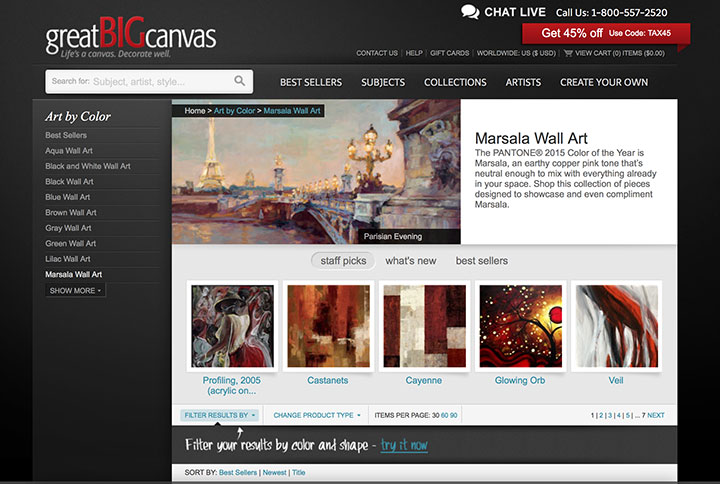Social Ecommerce, SEO and Smarter Marketing: Interview with Gavin Jocius
“It’s all about reaching people through social media for us,” explained Gavin Jocius, who manages three profitable ecommerce art websites with over $50M in annual revenue. “Social ecommerce means mobile monetization.”
 As the Executive Vice President for Art for CanvasOnDemand.com, Imagekind.com and greatBIGcanvas.com, Jocius’ goal is to sell art to “anyone who has walls.” More specifically he aims to entice family memory keepers into purchasing images on canvas. Jocius spends his days developing marketing campaigns, analyzing data, and overseeing the production and technology for these three websites.
As the Executive Vice President for Art for CanvasOnDemand.com, Imagekind.com and greatBIGcanvas.com, Jocius’ goal is to sell art to “anyone who has walls.” More specifically he aims to entice family memory keepers into purchasing images on canvas. Jocius spends his days developing marketing campaigns, analyzing data, and overseeing the production and technology for these three websites.
Jocius shared his successful approach and thinking in an interview with us. Learn from him in his own words below:
Q. Give us the gist of your recent presentation “SEO and Social Confluence” at the Internet Retailer Digital Design Focus conference in L.A.
A. The main question I answered in my talk was this: What impact does social media have on organic search ranking (if any)? Social media signals do have an impact. They help Google index certain pages quickly. Social signals are a content beacon. Facebook likes and shares or other social media engagement with a given webpage implies there is engaging content there.
For us it’s all about reaching people through social so they can make purchases in places like in the grocery line. To get people to buy on mobile, you’ve got to think about the products you push out on mobile. And the type of environment as well – they aren’t buying a Lexus while in line. These are impulse purchases. The average order value tends to be lower, maybe around $50, and you have to have a clear call to action – one that might be time-sensitive to get them to buy now.
It’s one part of an overall digital strategy, one spoke in a bigger wheel. Of course you need domain authority and quality back links as well. But making sure you have relevant content that matches the search intent of your users – not just the search keywords – that’s important.
Q. Give us an example of social media and SEO coming together in your work.
A. Each year in December, Pantone releases its “color of the year.” While you may not have heard of this, it’s a huge deal in the interior décor industry, and there is a lot of mystery and anticipation around it.
We know it’s coming so we are prepared. So, for example, in December 2014, they announce the color of the year for 2015 is marsala – it’s a dark red color. And our team immediately goes to work on this within five minutes, creating content around this color.
Within hours we had our content online, things like collections of art based around the color marsala. We quickly did Facebook, Twitter and Google+ campaigns targeted at interior designers and decorators that drove people back to our marsala content. These were the influencers who shared, tweeted and engaged with our content about this color.
These social signals pointed Google to the newly created content, and the next day we ranked #1 in organic search for “marsala wall art.” Events like that – when a lot of eyes are looking at the same place – they are opportunities. Find events that you can anticipate and respond quickly to jump on the trend.

The marsala wall art collection web page was online within hours after Pantone named marsala the color of the year for 2015.
Q. What work to do you do to improve user experience on your websites?
A. We use Usertesting.com. It’s phenomenal. It’s inexpensive, and it’s very easy to do. We set clear tasks for mobile or have people film their actions on mobile devices, things like that. Within an hour you have feedback – and you can get a broad range of users – those with fat fingers and skinny fingers and dum dums.
We have these huge aha moments. The testing really shows us pain points for our customers. It’s worth every penny and minute we spend on it. And when you have those aha moments, it’s the greatest feeling ever. They seem obvious once you see them, but you often need someone else to show you.
For example, on one of our sites we have this tool that allows you to change the words in a pre-designed canvas – put your favorite quote or some other words that mean something to you. But through testing we saw that people did not understand how it worked. So we changed the user interface to show their changes to the words in real time, side by side, and after a second, they got it. Then they started engaging deeply with the tool and making all kinds of customized canvas art.

This canvas customization tool was modified to be a side-by-side display and now reflects customer changes in real time. Remote unmoderated user testing showed that customers weren’t understanding the earlier iteration of the tool.
Also, speed counts big time. It’s the best thing you can do for user satisfaction especially thinking about social ecommerce and mobile device use. All data says nanoseconds count. To speed things up on our sites, we strip the mobile experience to bare bones, design for quick impulse purchases. For example, we might offer one product on mobile vs. eight on desktop.
Q. Where should ecommerce retailers be putting their attention right now?
A. Anyone who’s not focused on mobile, you might as well just quit now. You are basically like Kodak, and you are going to miss the complete transition to mobile like they missed the move to digital. It’s happening quickly. It’s such a groundswell, and it’s a great opportunity.
A keynote talk at the IRCE Digital Focus conference was by Michael Layne, the Internet Marketing Director at Fathead.com, and it was all about mobile design. The key insight he provided was that since mobile traffic is so massive, start by planning for mobile first. Responsive design can slow down your website, so only load what folks need to see on mobile for given pages. Your website has to be designed for mobile. It cannot be an afterthought – it needs to come first.
Think about Q4, what are people doing when they are waiting in line in Target? They are on their phones, looking for deals. People need to be able to browse easily on mobile even if your product isn’t going to be bought on the spot. For greatbigcanvas.com, we have a $250 average order value, so they aren’t likely to buy while in line, but orders start with them looking at our products on mobile – maybe they first saw them on Facebook.
And I should say it’s not just about smart social ecommerce, sellers must consider the multi-device world we are in now. The smart companies will help people transition between devices seamlessly.
One last thing, each day you have to be focused on your data. I remember someone saying without data you are just another person with an opinion. Get insights from your own web traffic.
I tell my team every day, “Don’t come to me with assumptions, come to me with data.” Assumptions can come from a loud squeaky wheel – such as two comments on a Facebook post, for example. But I deal with bigger trends, and I let the data tell me what to do. Now that we have quick access to data, there’s no excuse. Data should be part of your day-to-day process. The best people on my team known data, can run reports and run campaigns around data.

Jocius makes changes to CanvasOnDemand.com and his other sites based upon data analytics, which he monitors daily.
Q. What will shopping online look like in 10 years?
A. Shopping will be the equivalent of swiping your hand. Shake your butt and buy some milk. It’s going to be so intuitive. I tell my team, “I want people to butt dial and buy canvas. Make it that easy.” I envision a fully automated future that has perfectly targeted personalization. User preferences are going to be very well known and used by marketers.
A while ago I wrote a book called “The Age of Annoyance; Managing our Frustrations with Information Overload” that looks at the root causes of people’s annoyances with electronics and modern society. People can easily point out things that annoy them, such as slow drivers or long lines, but they have a harder time explaining why such things annoy them. The root cause of annoyance is this thing called norm violation – which is a violation of a reasonable expectation. When things don’t work the way they should, we get annoyed.
There’s a new norm that everything should be fast, easy and simple. When you don’t offer that, people get angry and pissed off.
No matter what the device – mobile or desktop or wearable, the aim is fast service and very smart recommendations in a frictionless conversion funnel. The ecommerce retailers who can do that will be the successful ones in the future.
